The UK national debt is the total amount of money the British government owes to the private sector and other purchasers of UK gilts (e.g. Bank of England).
- UK public sector net debt (ex public sector banks) was £2,685.6 billion or 98.1% of GDP (20 Dec 2024).
- The OBR have forecast substantial rises in UK debt over the coming decade because of demographic factors, putting strain on UK spending.
- Source: [1. ONS public sector finances,- HF6X] (page updated 20 Jan 2024)
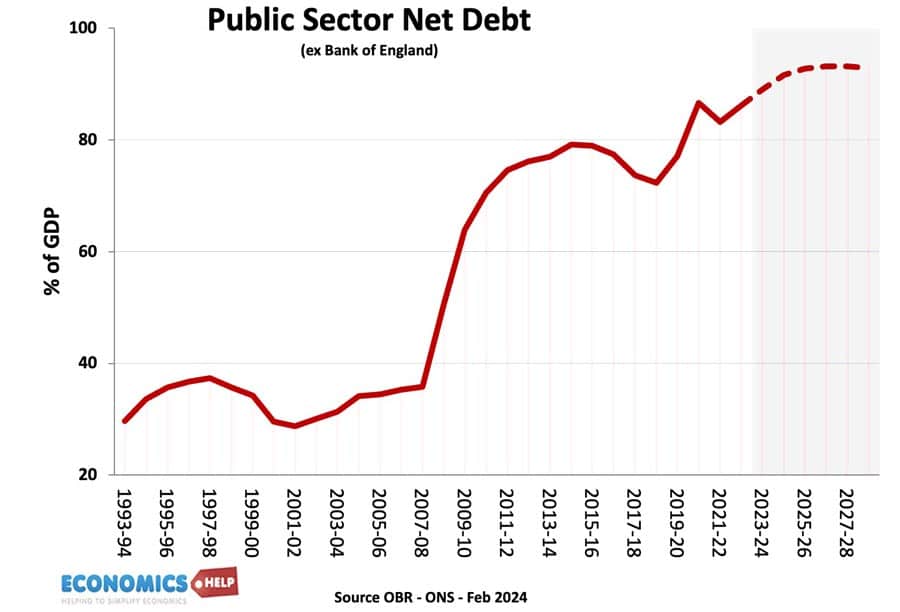
Source: ONS debt as % of GDP – HF6X | PUSF – public sector finances at ONS
Reasons for National debt
- Enables the government to spend more during periods of national crisis, e.g wars, pandemics, and recessions.
- In a recession, the government will automatically receive lower tax revenues (less VAT and income tax) and will have to spend more on benefits (e.g. more unemployment benefits) This causes a cyclical rise in debt.
- Extra government borrowing during a recession can help provide fiscal stimulus to promote economic recovery. By borrowing and then spending more, the government is injecting demand into the economy and this can help to reduce unemployment. This is known as fiscal policy and was advocated by J.M. Keynes.
- Strong market demand for government debt. Private investors buy gilts because they are seen as risk-free investments and there is also an annual dividend from the bond yield. Since 2009, there has been strong demand despite very low-interest rates, meaning the government can borrow very cheaply.
- Finance investment. The government could borrow to finance public investment projects that can lead to higher growth in the future.
- Political convenience. There is usually political pressure to cut taxes and increase government spending. Allowing debt to rise can be a way for the government to avoid difficult choices.
Forecast for the National debt?
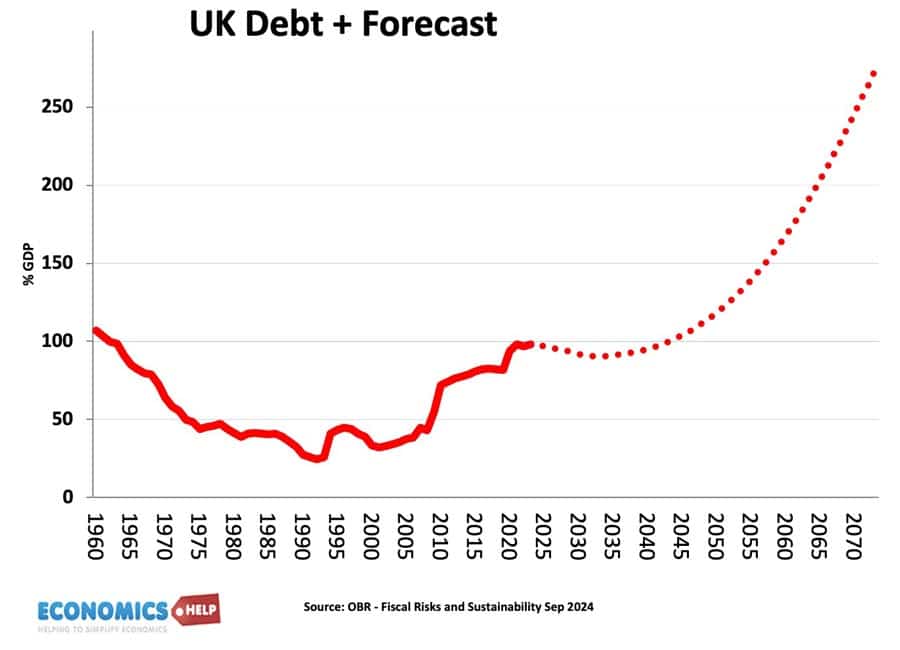
Source: Fiscal risks and sustainability – OBR – Economic and Fiscal Outlook Oct 2024
The OBR have forecast that, on our given trajectory, UK public sector debt could reach 350% of GDP within 50 years. The pessimistic outlook for national debt is made because
- An ageing population and demographic changes will put increased pressure on government spending, notably health care and pension spending.
- A smaller working population will limit UK’s productive capacity.
- Stress on finances from geopolitical events, such as frostier relations with China, Russia and the Middle East.
- Higher energy prices
- Costs of climate change.
- Declining tax revenues from petrol in a decarbonising economy.
- Low productivity growth of UK since the financial crash of 2009
- Recent boost to debt from the financial crisis and one-off cost of Coronovirus pandemic, which cut tax revenues and required government support for lockdown measures.
UK debt in context
Predicting debt for the next 50 years is difficult since we don’t know what kind of productivity improvements may come, e.g. continued gains in renewable energy may reduce the burden of higher oil and gas prices. Equally, the costs of environmental change could be worse.
History of the national debt

Main article: History of UK national debt
UK national debt since 1900

Source: Reinhart, Camen M. and Kenneth S. Rogoff, “From Financial Crash to Debt Crisis,” NBER Working Paper 15795, March 2010. and OBR from 2010.
These graphs show that government debt as a % of GDP has been much higher in the past. Notably in the aftermath of the two world wars. This suggests that current UK debt is manageable compared to the early 1950s. (note, even with a national debt of 200% of GDP in the 1950s, UK avoided default and even managed to set up the welfare state and NHS.
Debt reduction and growth
The post-war levels of national debt suggest that high debt levels are not incompatible with rising living standards and high economic growth.
- The reduction in debt as a % of GDP 1950-1980 was primarily due to a prolonged period of economic growth. See: how the UK reduced debt in the post-war period
- This contrasts with the experience of the UK in the 1920s when in the post First World War, the UK adopted austerity policies (and high exchange rate) but failed to reduce debt to GDP. Debt in Post-First World War period.
Budget deficit – annual borrowing
This is the amount the government has to borrow per year.
- Government
- borrowing in the financial year to December 2024 was £129.9
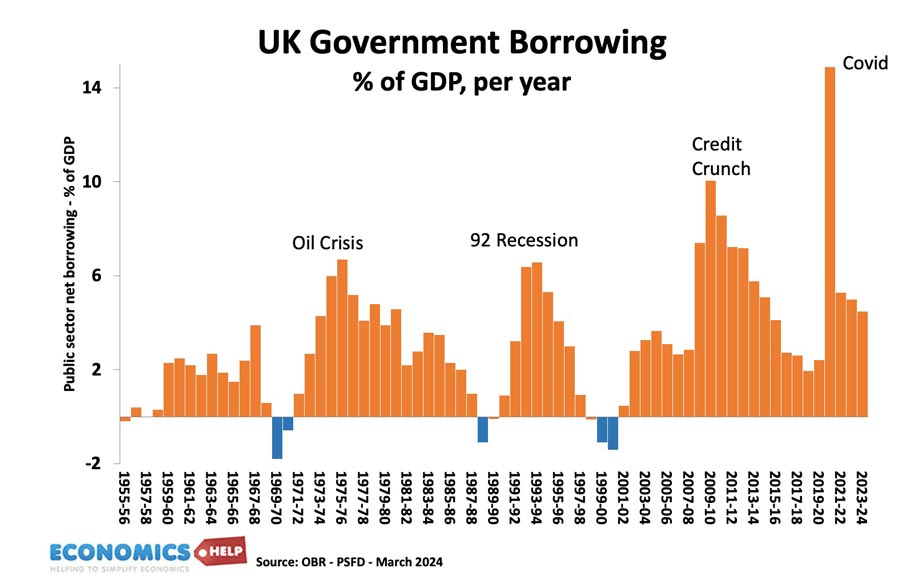
Annual borrowing since 1950. Figures for 2023-24 are forecasts (and rather optimistic!)
Debt and bond yields
Bond yields a the interest that the government pay bond/gilt holders. It reflects the cost of borrowing for the government. Lower bond yields reduce the cost of government borrowing.
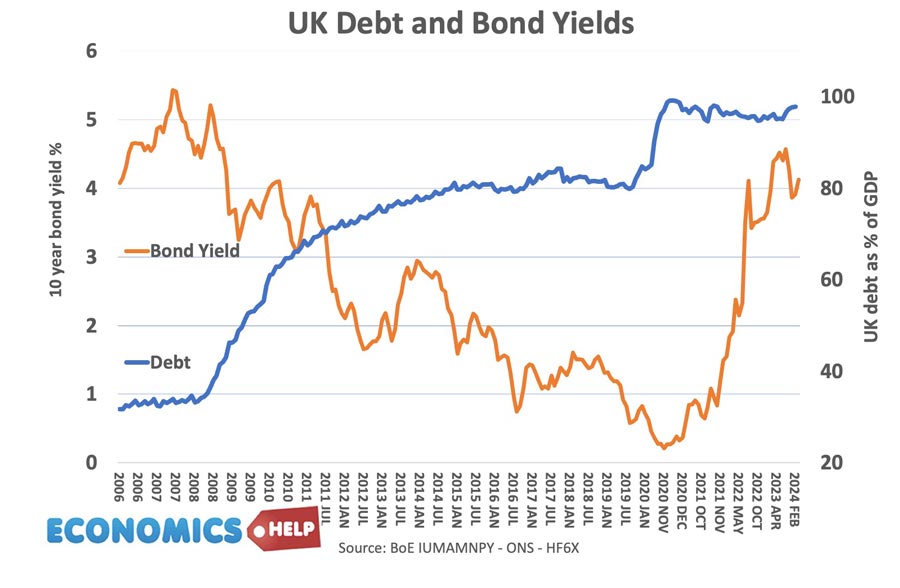
Between 2007 and 2020, UK bond yields fell. Countries in the Eurozone with similar debt levels saw a sharp rise in bond yields putting greater pressure on their government to cut spending quickly. However, being outside the Euro with an independent Central Bank (willing to act as lender of last resort to the government) means markets don’t fear a liquidity crisis in the UK; Euro members who don’t have a Central Bank willing to buy bonds during a liquidity crisis have been more at risk to rising bond yields and fears over government debt.
See also: Bond yields on European debt | (reasons for falling UK bond yields)
Since 2021, bond yields have risen due to pick up in inflation
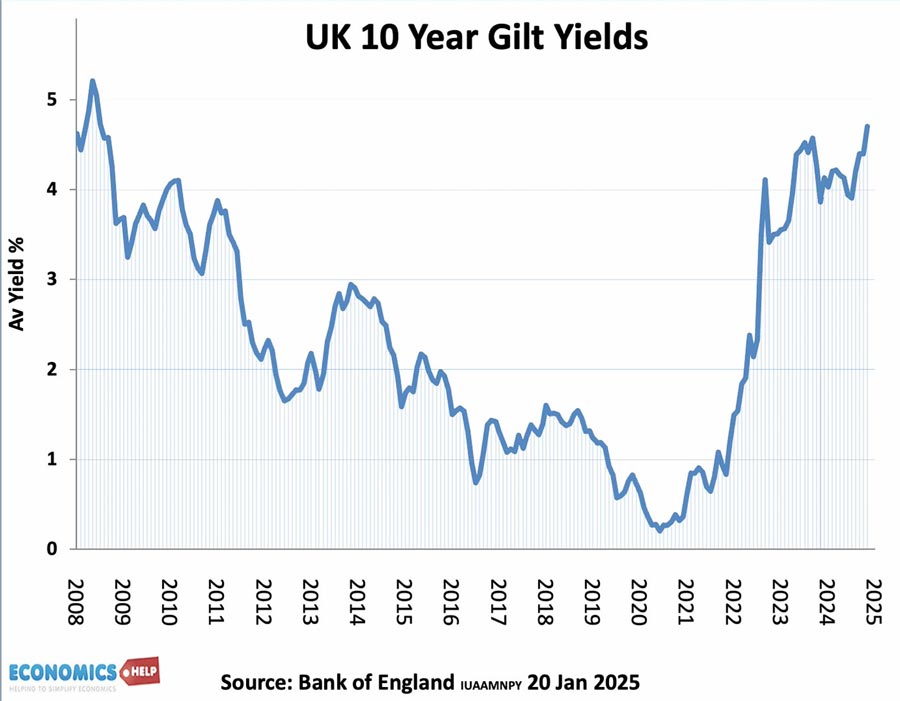
Cost of Interest Payments on National Debt
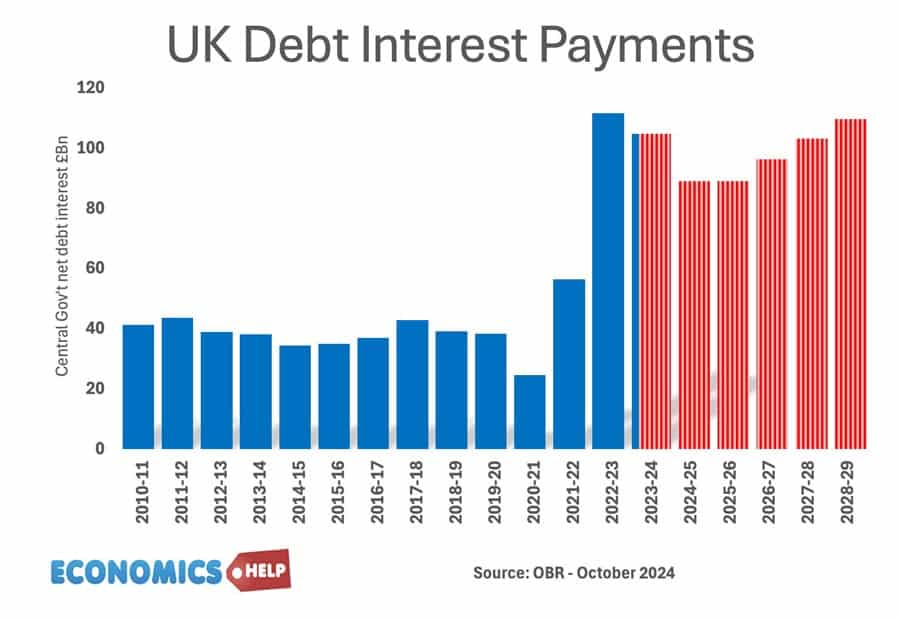
The cost of National debt is the interest the government has to pay on the bonds and gilts it sells. According to the OBR in 2023-24, debt interest payments will be £108 billion. (3.2% of GDP) or 5.2% of total spending. It is lower than in previous decades because of lower bond yields.
See also: UK Debt interest payments
The era of low interest rates post 1992 helped to reduce UK debt interest payments as a ratio of government revenue. However, with interest rates and borrowing increasing – debt interest cost have increased significantly.
Potential problems of National Debt
- Interest payments. The cost of paying interest on the government’s debt is very high. In 2011 debt interest payments will be £48 billion a year (est 3% of GDP). Public sector debt interest payments will be the 4th highest department after social security, health and education. Debt interest payments could rise close to £70bn given the forecast rise in national debt.
- Higher taxes / lower spending in the future.
- Crowding out of private sector investment/spending.
- The structural deficit will only get worse as an ageing population places greater strain on the UK’s pension liabilities. (demographic time bomb)
- Potential negative impact on the exchange rate (link)
- Potential of rising interest rates as markets become more reluctant to lend to the UK government.
However, government borrowing is not always as bad as people fear.
- Borrowing in a recession helps to offset a rise in private sector saving. Government borrowing helps maintain aggregate demand and prevents a fall in spending.
- In a liquidity trap and zero interest rates, governments can often borrow at very low rates for a long time (e.g. Japan and the UK) This is because people want to save and buy government bonds.
- Austerity measures (e.g. cutting spending and raising taxes) can lead to a decrease in economic growth and cause the deficit to remain the same % of GDP. Austerity measures and the economy | Timing of austerity
Who owns UK Debt?
The majority of UK debt used to be held by the UK private sector, in particular, UK insurance and pension funds. In recent years, the Bank of England has bought gilts taking its holding to 25% of UK public sector debt.

Source: DMO Debt Management Report 2022/23
- Overseas investors own about 28% of UK gilts (2022).
- The Asset Purchase Facility is purchases by the Bank of England as part of quantitive easing. This accounts for 26% of gilt holdings.
Total UK Debt – government + private
- Another way to examine UK debt is to look at both government debt and private debt combined.
- Total UK debt includes household sector debt, business sector debt, financial sector debt and government debt. This is over 500% of GDP. Total UK Debt
Private sector savings
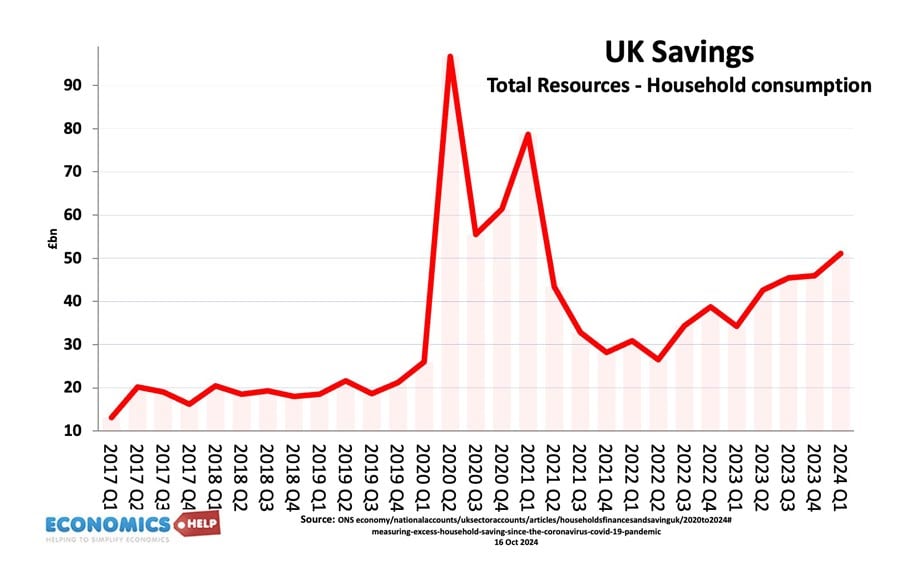
When considering government borrowing, it is important to place it in context. From 2007 to 2012, we have seen a sharp rise in private sector saving (UK savings ratio). The private sector has been seeking to reduce their debt levels and increase savings (e.g. buying government bonds). This increase in savings led to a sharp fall in private sector spending and investment. The increase in government borrowing is making use of this steep increase in private sector savings and helping to offset the fall in AD. see: Private and public sector borrowing
Comparison with other countries
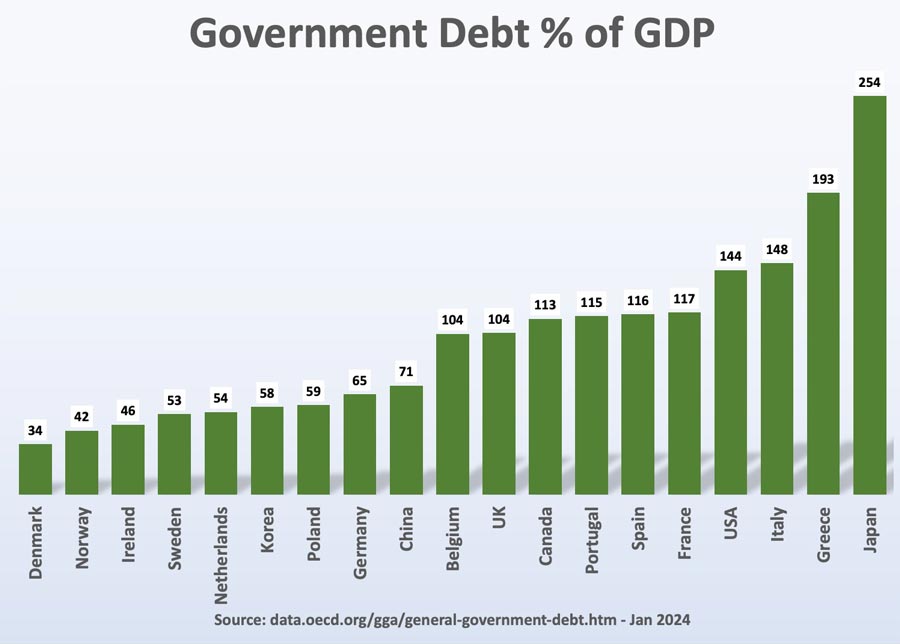
Although 107% of GDP is high by recent UK standards, it is worth bearing in mind that other countries have a much bigger problem. Japan, for example, has a National debt of 256%, Italy is over 157%. The US national debt is over 132% of GDP. [See other countries debt].
How to reduce the debt to GDP ratio?
- Economic expansion which improves tax revenues and reduces spending on benefits like Job Seekers Allowance. The economic slowdown which has occurred since 2010 has pushed the UK into a period of slow economic growth – especially if we consider GDP per capita growth. Therefore the further squeeze on tax revenues has led to deficit-reduction targets being missed.
- Government spending cuts and tax increases (e.g. VAT) which improve public finances and deal with the structural deficit. The difficulty is the extent to which these spending cuts could reduce economic growth and hamper attempts to improve tax revenues. Some economists feel the timing of deficit consolidation is very important, and growth should come before fiscal consolidation.
- See: practical solutions to reducing debt without harming growth
Other countries debt
See also:

The ‘Government’ does not ‘owe’ this money, THE TAXPAYER DOES. The only money that the Government has is what it collects from US THE PEOPLE.
I think it helps to understand what taxation is . I define it as follows:
Taxation – A portion of purchasing power that is transferred from the workers /Investors in the Private Sector to:
1) The suppliers in Public Sector(Public Sector Suppliers)
2) Members of the population at large who are judged to be worthy recipients.
3) National and international creditors who have lent money to the country(i.e Interest payments)
Note:Those workers /investors in the Private sector who are suppliers to the Public Sector(in part or in whole) are to be regarded as Public Sector Suppliers in the context of this definition
So many of ‘US ‘the people are net recipients of Tax (i.e purchasing power) and not net contributors.
@Ade
Oh dear. Let me explain to you that printing money is a tax. When the government prints money, it raises inflation. This directly reduces how much you can buy with your salary. ie It has exactly the same effect as raising income tax, except that because it directly devalues sterling, it hits everyone, including those on benefits.
The link between quantity of money and inflation has weakened in recent years. Factors bearing on prices are (a) value of your currency relative to those you trade with, and (b) the costs of production in countries that sell you products e.g oil products, China. Under Greenspan money supply in US was loosened without any impact on inflation cos cheap Chinese products flooded in. But the most important factor is that asset prices don’t figure in inflation figures, so if house prices soar because of loose money then it does not figure in the statistics even though it is the most important price of them all (just ask young people trying to get on the ladder). Ditto share prices, derivatives and the complete raft of financial assets. We are supposedly all in love with these assets when they rise in price but (a) these assets don’t actually produce anything in the ‘real’ economy (goods and services) and (b) when their price rises people who do not possess them can’t afford them.
We have had two rounds of quantitative easing and inflation has hardly been affected – the cause of current inflation is the rise in commodity prices which is due to global factors and the weak value of the pound.
So no I do not agree that QE will cause inflation.
A response I made to someone who linked this article to me.
”
Just on a brief glimpse the article justifies high debt levels with comparisons to Italy (not the best example on hindsight) and Japan (which has the advantage of a domestic population that really likes to save and buy government bonds, thus not relying as heavily on markets/governments ect).
Yes our government had a higher debt level after world war 2, our economy was in little pieces and it took a long time to pay back the US, this is not a situation we wish to repeat. We also enjoyed rather nice periods of growth, which helped quite substantially. The world is also a different place now, we are far more globalised, interconnected ect. The risks are far higher, we are not special.
Bond yields are low largely because markets have faith in our seriousness and ability to tackle the deficit. (It is also helped by the rounds of QE where the government has been buying our own bonds helping to decrease the price of borrowing). Using it as a reason to not take the debt/deficit seriously is a little silly considering the reason is so low is because we are tackling the deficit (although the argument could be made that we could ease the pace/depth a little in response to this. We still couldn’t make a U-turn).
It then mentions that the cost of the national debt is increasing noting that it was £48.6 bn (which is more than we spend on the military) and is larger than some of the cuts that we are making. Not sure what its point it’s trying to make is. It seems to highlight that it is a big problem that is getting bigger and should be tackled. Or maybe it awkwardly left it there in hopes that no one would notice it.
It then goes onto mention how future national debt is still going to increase up to 2015 (not sure how this is helping its argument). It then talks about economic expansion without explaining how it would achieve this (yes it would help tackle the debt/deficit, the question is how). It makes the point of how taxes/spending cuts can dampen growth, once again it is correct, they can. What are the alternatives though and would it be less dangerous to pursue the course its advocating.
“Problems of National Debt
Interest Payments. The cost of paying interest on the government’s debt is very high. In 2011 Debt interest payments will be £48 billion a year (est 3% of GDP). Public sector debt interest payments will be the 4th highest department after social security, health and education. Debt interest payments could rise close to £70bn given the forecast rise in national debt. Higher Taxes / lower spending in the future. Crowding out of private sector investment / spending The structural deficit will only get worse as an ageing population places greater strain on the UK’s pension liabilities. (demographic time bomb) Potential negative impact on exchange rate (link) Potential of rising interest rates as markets become more reluctant to lend to the UK government.”
Worth reading that bit of the page, not very easy to dismiss as easily as the author does.
It then talks about different types of debt, we might not top all of them in terms of GDP per capita, but we do worst overall.
Simply put bills have to be paid eventually, economics is complicated and my fingers hurt.
“
could you inform the Intergenerational Foundation of the national debt history and also how much is owed to Britain as I don’t understand economics that well and your site makes it clear, however, it seems to conflict with their statement account. thank you
I think as a country we ought to be proud of what we have achieved seeing how debt has dropped proportionately in the first graph: UK National Debt since 1918. We are pulling back to keep the country ticking over financially and it seems that there is a plan, despite the “naysayers” in how to maintain it.
The other areas which need to be addressed which affects us individuals and groups is not in this remit and the power to put that right is in the hands of government and the industrial leaders.
That is good kind of collective information u have and it was very helpful for all of us. I have also that kind of information on it.. http://worldsseconomy.blogspot.com/2011/06/economy-of-uk.html
Thank you very much.I solve many qns from your discussion.
Thanks again
I wonder if that 07 spike is from the toxic cd infection from the US, or bail out money extorted out of Europe by the US. We got terrorized Americans thinking the world is going end on this one and after 100 years of this jack it up and tear it down b.s their is no one to reign in the evil oligarchs.
According to various websites the uk are currently over £1trillion in debt but like every other country, we are owed probably the same amount from various countries. I have seen that the US owe us between £400 and £500 billion. Now I asked well why do we not say to the US we want our money. Now i was answered saying it would be stupid to do that because it was cause a war between countries. Which to I have answered ‘will it not become war if we keep taking money from other and they take money from us and not paying it back not cause an even worse war?